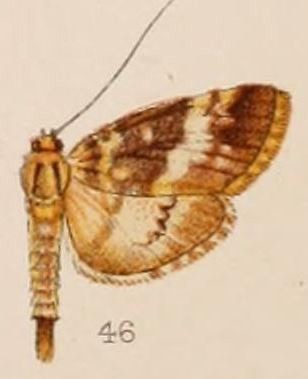
Lygropia is a genus of snout moths in the subfamily Spilomelinae of the family Crambidae. It currently comprises 66 species, which are mostly found in the tropical and subtropical regions of the Americas, Africa and Asia, but not in Australia.
Inopsis funerea is a moth of the family Erebidae. It was described by Augustus Radcliffe Grote in 1883. It is found in North America, where it has been recorded from Arizona and South Carolina.
Pygarctia abdominalis, the yellow-edged pygarctia or orange-bodied pygarctia, is a moth in the family Erebidae. It was described by Augustus Radcliffe Grote in 1871. It is found in the United States from New Jersey south to Florida and west to Texas.
Elophila ekthlipsis, the nymphula moth, is a moth in the family Crambidae. It was described by Augustus Radcliffe Grote in 1876. It is found in North America, where it has been recorded from the Great Lakes area, including Indiana, Maine, Michigan, Minnesota, New Brunswick, New Hampshire, Ohio, Ontario, Quebec and Wisconsin. The habitat consists of ponds and marshes.
Petrophila avernalis is a moth in the family Crambidae. It was described by Augustus Radcliffe Grote in 1878. It is found in North America, where it has been recorded from Arizona, Colorado, New Mexico, South Dakota and Wyoming.
Agriphila attenuata is a moth in the family Crambidae. It was described by Augustus Radcliffe Grote in 1880. It is found in North America, where it has been recorded from coastal California, Washington, Wyoming, British Columbia and Alberta. The habitat consists of grasslands.
Thaumatopsis edonis is a moth in the family Crambidae. It was described by Augustus Radcliffe Grote in 1880. It is found in North America, where it has been recorded from Florida, Kentucky, Maine, Massachusetts, Mississippi, Missouri, Nebraska, New Jersey, Oklahoma and South Carolina. It is listed as threatened in the US state of Connecticut.
Evergestis obliqualis is a moth in the family Crambidae. It was described by Augustus Radcliffe Grote in 1883. It is found in North America, where it has been recorded from Arizona, California, Colorado, New Mexico, Texas and Utah.
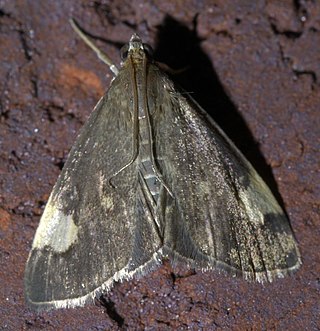
Evergestis unimacula, the large-spotted evergestis moth, is a moth in the family Crambidae. It was described by Augustus Radcliffe Grote and Coleman Townsend Robinson in 1867. It is found in North America, where it has been recorded from Georgia, Illinois, Indiana, Iowa, Maryland, Michigan, North Carolina, Ohio, Oklahoma, Ontario, Pennsylvania, Quebec, Tennessee and West Virginia. Outliers have been recorded from Florida.

Loxostege albiceralis is a moth in the family Crambidae. It was described by Augustus Radcliffe Grote in 1878. It is found in North America where it has been recorded from southern California and Nevada to Texas. The habitat consists of arid areas and deserts.

Loxostege allectalis is a moth in the family Crambidae. It was described by Augustus Radcliffe Grote in 1877. It is found in the United States, where it has been recorded from southern California to Texas, and to Central America.
Pyrausta tatalis is a moth in the family Crambidae. It was described by Augustus Radcliffe Grote in 1877. It is found in North America, where it has been recorded from California to Texas and Oklahoma.
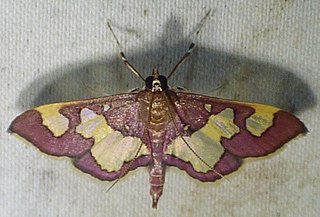
Colomychus talis, the distinguished colymychus moth, is a moth in the family Crambidae. It was described by Augustus Radcliffe Grote in 1878. It is found in Mexico and the south-eastern United States, where it has been recorded from Alabama, Arkansas, Florida, Georgia, Maryland, North Carolina, Oklahoma, South Carolina and Virginia.
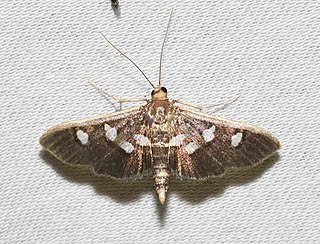
Desmia subdivisalis is a species of moth in the family Crambidae. It was described by Augustus Radcliffe Grote in 1871. It is found in the West Indies, Mexico and the United States, where it has been recorded from Florida to New Mexico, Illinois, Maryland and California.

Diacme adipaloides, the darker diacme moth, is a moth in the family Crambidae. It was described by Augustus Radcliffe Grote and Coleman Townsend Robinson in 1867. It is found in North America, where it has been recorded from Alabama, Arkansas, Florida, Indiana, Maine, Maryland, Massachusetts, Michigan, Minnesota, New Brunswick, New Hampshire, New Jersey, New York, North Carolina, Nova Scotia, Ohio, Oklahoma, Ontario, Quebec, South Carolina, Tennessee, Texas, Virginia, West Virginia and Wisconsin. Adults have been recorded year round.
Eulepte anticostalis is a moth in the family Crambidae. It was described by Augustus Radcliffe Grote in 1871. It is found in North America, where it has been recorded from Florida to North Carolina and west to Texas. It is also found on Puerto Rico.
Eurrhyparodes lygdamis is a moth in the family Crambidae. It was described by Herbert Druce in 1902. It is found in the United States, where it has been recorded from Florida to Texas and from Mexico to Brazil.
Loxomorpha flavidissimalis is a moth in the family Crambidae. It was described by Augustus Radcliffe Grote in 1877. It is found in the United States, where it has been recorded from Texas, Florida, North Carolina and West Virginia. It is also found in Mexico and Puerto Rico. It has also been recorded from Australia.
Lygropia fusalis is a species of moth in the family Crambidae. It was described by George Hampson in 1904. It is found on the Bahamas, in Costa Rica, Cuba and Florida.
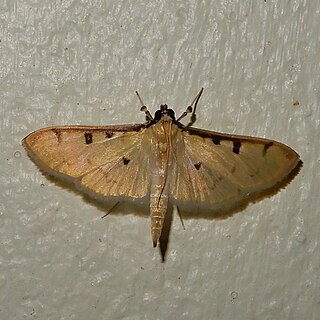
Lygropia tripunctata, the sweetpotato leafroller, is a species of moth in the family Crambidae. It was described by Johan Christian Fabricius in 1794. It is found in the United States, where it has been recorded from Texas to South Carolina and Florida. It is also found from the West Indies and Central America to Brazil.







